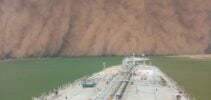There are several factors that contribute to the formation of sandstorms. One of them is the presence of strong winds that can lift sand particles from the soil. Another factor is the availability of loose sand particles or sandy soils, which are more susceptible to being lifted by winds. Furthermore, the absence of adequate vegetation to anchor the soil also facilitates the erosion process and contributes to the formation of these storms.
ADVERTISING
Sandstorms can be dangerous for several reasons:
Firstly, the dense sand cloud significantly reduces visibility, making navigation difficult and potentially causing traffic and air accidents. Furthermore, inhaling fine sand particles can be harmful to your health, affecting the respiratory system and causing problems such as irritation, allergies and respiratory illnesses. Moving sand can also cause damage to buildings, vehicles and electrical systems, as well as disrupt agricultural activities and affect wildlife.
To protect yourself from sandstorms, it is important to follow some precautions. Staying in a safe and secure location, such as a solid building, is essential. It is recommended to avoid driving during the storm, but if necessary, it is important to reduce speed and use low beam headlights to increase visibility. Using masks or moist wipes to protect the respiratory tract is also advisable. Additionally, it is important to stay informed about local weather conditions through weather reports.
*The text of this article was partially generated by ChatGPT, an artificial intelligence-based language model developed by OpenAI. Text entries were created by Curto News and responses intentionally reproduced in full. The answers from ChatGPT are automatically generated and do not represent the opinions of OpenAI or people associated with the model. All responsibility for published content rests with Curto News.
ADVERTISING
Fonts used by ChatGPT:
- Hsiao, T. C., & Hsu, N. C. (2018). Sand and dust storm: concepts, measurements, and dynamics. In Sand and Dust Storms (pp. 1-8). Elsevier.
- Prospero, J.M., Ginoux, P., Torres, O., Nicholson, SE, & Gill, TE (2002). Environmental characterization of global sources of atmospheric soil dust identified with the Nimbus 7 Total Ozone Mapping Spectrometer (TOMS) absorbing aerosol product. Reviews of Geophysics, 40(1), 1-31.
- US Environmental Protection Agency. (2019). Sand and Dust Storms: Impact, Mitigation, and Prevention. Retrieved from https://www.epa.gov/international-cooperation/sand-and-dust-storms-impact-mitigation-and-prevention
Read also




